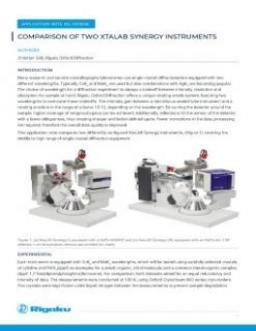Introduction
Many research and service crystallography laboratories use single crystal diffractometers equipped with two different wavelengths. Typically, CuKα and MoKα are used but also combinations with AgKα are becoming popular. The choice of wavelength for a diffraction experiment is always a tradeoff between intensity, resolution and absorption for sample at hand. Rigaku Oxford Diffraction offers a unique rotating anode system, featuring two wavelengths to overcome these tradeoffs. The intensity gain between a microfocus sealed tube instrument and a rotating anode is in the range of a factor 10-12, depending on the wavelength. By curving the detector around the sample, higher coverage of reciprocal space can be achieved. Additionally, reflections hit the sensor of the detector with a lower obliqueness, thus creating sharper and better-defined spots. Fewer corrections in the data processing are required, therefore the overall data quality is improved.
This application note compares two differently configured XtaLAB Synergy instruments, covering the middle to high range of single crystal diffraction equipment..

